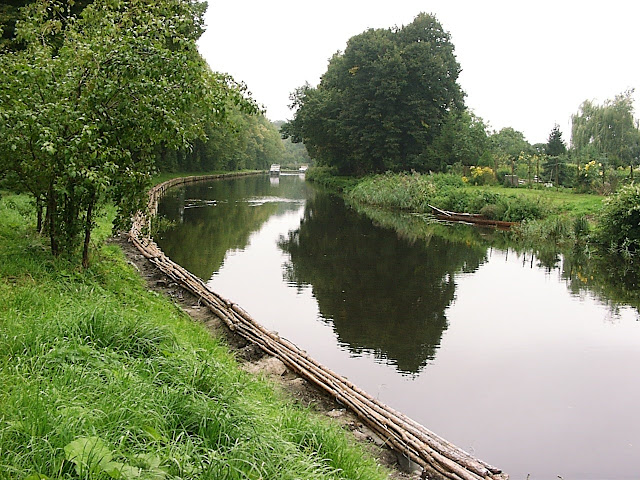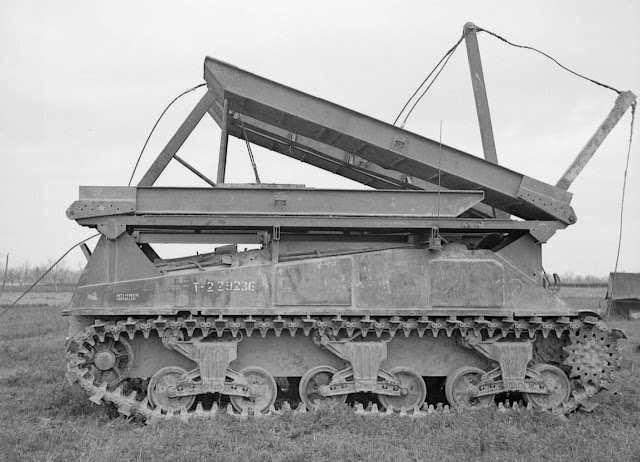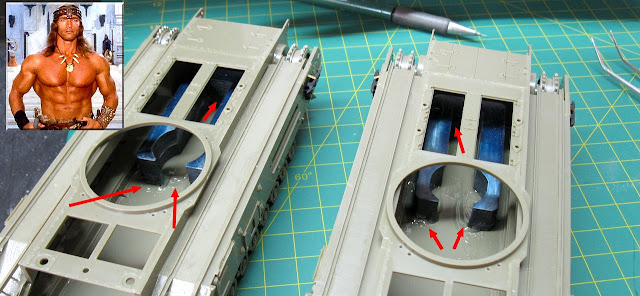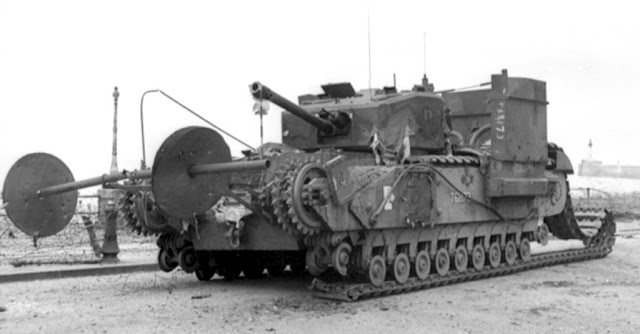Watch out... ditch ahead!!!
The tank in this report is one of Hobart's famous Funnies! Its main feature is to use a device almost as old as the History of Wars, to pave the way for his companions... I proudly present to you the Churchill AVRE fascine carrier.
 |
| Churchill Mk.IV AVRE fascine carrier towing a fascine sledge (notice the steel rope in the AVRE's rear hook) Reichswald Forest , Germany - Operation 'Veritable'. 8 February, 1945. |
History:
After the bloody landing attempt at Dieppe (Operation Jubilee) in August 1942, the Allies tried to absorb the lessons of the failed landing that were exposed that day. The fact that the many tanks and other military vehicles simply could not leave the sands of the landing beach were the determining factor in the failure of the Operation.
 |
| We can say that many lessons on how to invade France were learned during Operation Jubilee, but at a terrible cost to Canadian and British soldiers. Dieppe, France - August - 1942. |
Interestingly, even in this frustrated landing, some special vehicles were used, such as Churchills bobbins and flamethrowers, but still very primitive and fragile versions, which contributed very little to the success of the mission.
 |
| Churchill Oke in development and operational versions. See more details here, on Bunker. |
With that in mind, the British Ministry of Defense developed work teams to try to solve the issue and, like everything in wartime, the solution would have to be cheap and accessible... and many strange things were born from this premise.
One of the best examples was the development of the Churchill AVRE (Armoured Vehicle Royal Engineers) tank, armed with a powerful barrier-destroyer mortar and which could be equipped with various equipment, from bridge launchers to fascination carriers, the latter being the objective of this article. A good historical review of Churchill AVRE tanks can be found here, on Bunker.
 |
| Churchill Mk IV AVRE roaring in a dirty village in Belgium - 18 September 1944. |
These tanks were assigned to the 79th Armored Division, under the command of General Percy Hobart and which became known as Hobart's Funnies, because of the strange appearance of these vehicles.
 |
and the badge of the 79th Armoured Division |
Churchill AVRE fascine carrier:
Fascine is a rough bundle of brushwood or other material used for strengthening an earthen structure, or making a path across uneven or wet terrain. Typical uses are protecting the banks of streams from erosion, covering marshy ground and so on.
%20used%20to%20protect%20the%20dunes%20from%20erosion..jpg) |
| Fascines near the tip of Percho ( Côte Sauvage de Saint-Pierre-Quiberon ) used to protect the dunes from erosion. |
 |
| Riverbank was strengthened with fascines. Templin Channel in Templin, Germany. |
 |
| The use of fascines to protect the riverbanks Boulages, France |
In war they have often been used to help armies – in modern times, especially tanks and other vehicles – cross trenches, valleys, marshes, walls, muddy or uneven terrain, etc.
 |
| The Battle of Narva - November 1700 Alexander Kotzebue painting |
 |
| British Mark IV Female heavy tank with fascine aboard flat-bed railway trucks at Plateau Station. Notice the canvas, protecting the tank from rain moisture. Preparations for the Battle of Cambrai. November - 1917. |
 |
| An unfortunate British Mk.IV Female heavy tank which fell into a prepared pit during the Battle of Cambrai. Bourlon, February 1918 |
 |
| British Mark IV Female heavy tanks with fascines being loaded aboard flat-bed railway trucks at Plateau Station, in preparation for transportation to the forward area prior to the opening of the Battle of Cambrai. November - 1917. |
.%20Mark%20V%20%20with%20the%20'cribs'%20carried%20to%20cross%20the%20Hindenburg%20Line,%20Bellicourt,%2029th%20September%201918.jpg) |
| British Mark V heavy tanks with the "cribs" carried to cross the Hindenburg Line - Bellicourt - Battle of St Quentin Canal France - 29th September 1918 |
 |
| A Churchill Mk.IV 6 pdr. tank of 163rd Brigade, 54th Division, pouring a fascine, during ditch crossing exercises near Dunwich, England. 14 April 1943 |
 |
| Fascines unloaded into the ditch now make it possible for the tank to cross the gap. Churchill Mk.III 6 pdr. tank "SATAN" seen crossing a ditch. Trials near Dunwich, England. 14 April 1943 |
 |
| The same Churchill Mk.III 6 pdr. tank "SATAN" seen above. Trials near Dunwich, England. 14 April 1943 |
 |
| A Churchill Mk.IV 6 pdr. tank climbing over several fascines, gaining height to overcome a vertical obstacle. Testing an old and innovative concept at the same time. Dunwich, England - 14 April 1943 |
 |
| Testing the concept of Churchill fascine carrier on England trials - 9 December 1943 The tank is a Churchill Mk.IV with an unarmed turret. |
 |
| Here's an example of a bad idea!!! |
Churchill AVRE fascine carrier:
Fascines were a group of sticks (bush), tied together, forming bundles and sub-bundles, tied together in a large roll.
 |
| Fascine bundle in tests. Notice the canvas "strap" of the initial models, later simplified to simple ropes. Development Unit - 79th Armoured Division Suffolk - September, 1943. |
With approximately 2 to 2.5 meters in diameter and approximately 3.5 meters in width, they could be entirely formed by sticks or have prefabricated metal tubes (generally 3) installed in the center of the roll, to act as a culvert, for water drainage.
 |
| Churchill AVRE fascine carrier moving up to the battle. Notice the prefabricated metal tubes in the fascine's core. 53rd Division's attack - west of Oss - Holland 23 October 1944 |
 |
| Wood cradle in tests. Notice the fascines in the background. Development Unit - 79th Armoured Division Suffolk - September, 1943. |
The fascine was placed in the cradle and fixed by moorings, with a tensioning cable going to the rear of the vehicle. The fascine was released could be released by a mechanical quick-release trigger (with its activation being done inside the turret) or a explosive quick release system: a detonator was inserted into the plastic explosive and an electrical trigger cable led to the interior of the turret, too. The explosion released the mooring lines and the fascine rolled forward into the crib.
 |
| Churchill Mk.IV AVRE fascine carrier - rear view Notice the fascine explosive release device: two steel plates bolted together, with plastic explosive inserted between the plates. |
Additional fascines could be towed by the AVRE on a stel sledge.
 |
| Churchill Mk.IV AVRE towing a steel sledge full of fascines. Netherlands - October, 1944. |
Unfortunately, the presence of the fascines on the bow of the tank made it difficult the driver's view, (which was already quite restricted in the normal Churchills) and obliterating the forward view of the tank commander, either through the periscopes or through the direct view through the turret hatch. For this reason, it was very common for the tank commander to stay outside the AVRE (with great danger to him...), perched on the fascine, to assist in the visual field of the driver and the tactical situation of the tank in the field.
 |
| Churchill AVREs fascine carriers and Churchill ARKs passing through Forli, Italy Notice the Churchill AVRE's comanders in the top of fascines. 9 November 1944 |
Another problem was that while the tank was carrying the fascine, the mortar could only be fired from a perpendicular derivation of the turret.
 |
| Churchill Mk.IV with fascine. Notice the unarmed turret pointing to front position. |
 |
| Another Churchill Mk.IV AVRE fascine carrier, but with unarmed turret rotate in 90°, to right position. |
But despite all these problems, the AVRE fascine carrier was quite successful in filling walls, trenches, tank traps, and other voids, allowing it and the remaining allied vehicles to cross and advance.
 |
| Churchill AVRE fascine carrier approaching its primary objective: a ditch to be filled. |
One of the unforeseen uses of the fascine carrier in the Normandy Landings was to fill in the large craters created by the guns of Allied battleships and heavy bombers, during the bombardment of the rear areas of the landing beaches. Some of these projectiles and bombs each weighed 500 kilograms of high explosives, which created immense craters that could swallow up to two or three tanks. Once freed from the fascine and rack, the AVRE could continue as a conventional armored vehicle.
The Churchills AVRE fascine carriers although they were designed to perform on D-Day in Normandy (24 were used on the day of the Landing), they were so successful that they were used in the most varied Theaters of Operations in WWII, including Netherlands, Italy and the final advance on Germany.
 |
| Churchill AVRE fascine carrier passing by infantry during the attack towards Hertogenbosch in Netherlands. 23 October 1944 |
 |
| Canadian Churchill Mk.IV AVRE fascine carrier still with his cargo, passing through the streets of newly liberated Apeldoorn, Netherlands. 17 April, 1945. |
 |
| Churchill Mk.IV AVRE fascine carrier towing a fascine sledge (notice the wire rope in the AVRE's rear hook). 34th Independent Tank Brigade Reichswald Forest , Germany - Operation 'Veritable'. 8 February, 1945. |
 |
| Churchill ARK fascine carrier. Trials in United Kingdom - late march, 1944. |
 |
| The same Sherman fascine carrier of pic above - front view The second bundle of fascine being loaded onto the vehicle. 2nd Armoured Brigade REME Ronco, near Forli - Italy - early April 1945. |
 |
| Sherman V Twaby Ark with their ramps folded 2nd Armoured Brigade REME Notice the extra-large grousers in the tracks. Ronco, near Forli - Italy - early April 1945. |
 |
| Same Sherman V Twaby Ark seen above. 2nd Armoured Brigade REME Notice the extra-large grousers in the tracks. Ronco, near Forli - Italy - early April 1945. |
 |
| Churchill Mk.VII AVRE (L9 - 165mm bore demolition gun) with "old-school" bundle of wood fascine United Kingdon -1955 |
 |
| Centurion AVRE with L9 - 165mm bore demolition gun passing over a beam of fascines in tubes. United Kingdon -1964 |
 |
| Chieftain AVRE ‘CHAVRE’ with tube fascines. KFOR - Kosovo - 2000 |
%20is%20pictured%20carrying%20a%20fascine%202005.jpg) |
| Chieftain Armoured Vehicle Royal Engineers (AVRE) carrying two bundles of tube fascines 2005 |
 |
| Challenger II Trojan AVRE mine clearing with tube fascines Afganistan - 2009 |
Specs:
Churchill Mk IV AVRE fascine carrier | |
|---|---|
Type | Infantry - sapper tank |
Place of origin | United Kingdom |
Service history | |
In service | 1941–52 |
Used by |
|
Production history | |
Designer | |
Manufacturer | |
Produced | 1941 to 1945 |
Number built | 754 AVRES |
Variants | Mk.III & Mk.IV |
Specifications | |
Weight | 40.1 tons |
Length | 7.44 m |
Width | 3.25 m |
Height | 2.49 m |
Crew | 6 |
Armour |
|
Main armament | Spigot mortar 290mm firing "Flying Dustbin" 18 kg petard (26 rds) |
Sec. armament |
|
Engine | Bedford 12-cyl., 4 stroke, water-cooled, horizontally opposed, L-head petrol engine 350 hp @ 2,200 rpm |
Power/weight | 9.1 hp / tonne |
Transmission | Merritt-Brown 4-speed constant-mesh epicyclic gearbox |
Suspension | Coiled spring |
Op. range | 90 km |
Speed | 24 km/h |
Steering system | Triple differential steering in gearbox |
The kits:
This time, the characters of our novel are the kits Churchill Mk.IV AVRE w/ Fascine Carrier FrameAFV Club (# AF35288)...
 |
Churchill Mk.IV AVRE w/ Fascine Carrier Frame AFV Club (# AF35288) kit box art |
...and the amazing fascine resin kit from Hobby Fan Lumber Bundles (# HF079):
 |
| Hobby Fan Lumber Bundles (# HF079) kit box art |
 |
| My workbench with the bald one, ready for action!!! |
 |
| Amazing resin kit !!! Very well done, Hobby Fan!!! |
 |
| Impressive details... |
 |
| I couldn't resist doing a dry-run... The fitting of the pieces is a bit random... you have to choose the best position of the pieces, especially the external ones... |
 |
| Building the suspensions of the tank... |
 |
| Churchill AVRE fascine carrier in parallel with the Churchill AVRE SBG assault bridge |
 |
| Suspensions almost ready... |
 |
| I love these AFV Churchills... |
 |
| Churchill AVRE fascine carrier and Churchill AVRE SBG assault bridge hulls... |
 |
| "Crushing" the front suspensions to simulate the weight of the future big bundle of fascine. I glued the suspension components in that position... |
 |
| Gluing the ballasts with quick two-component epoxy adhesive... |
 |
| Epoxy adhesive gluing the ballasts. Super strong, by Crom!!! |
 |
| I also reinforced it with sprue and acrylic (see details, here). Hull front view |
 |
| Rear view |
 |
| Cleaning the 3 burrs of the engine safe locks is so annoying (the parts are very fragile) that it is better to replace the whole thing with metal: copper wires in the correct diameter and lengths... |
 |
| Lads celebrate!!! |
 |
| Now, it´s turret time: the Mk.IV rounded one... |
 |
| Turret done - left view |
 |
| Turret done - right view |
 |
| And the turret in place... Indeed, the girl is awesome!!! |
 |
| Right view |
 |
| Rear view |
 |
| Building the crib respecting the squaring |
 |
| The Churchill with and without flaps in his periscopes... The young Liz was happy with the repair!!! |
 |
| The crib in an adaptation test |
 |
| Notice that the periscopes without the flaps fit perfectly now... |
 |
| After cutting (with a knife) a part of the E4 part, you fit the F11 and re-glue the cut part, securing the F11 inside the E4. |
 |
| And then, repeating the process with the other handle. |
 |
| And the E4+F11 couples installed in Churchill's rear. |
 |
| Making the wire rope according to the kit instructions... |
 |
| And building the fascine quick release trigger. The red dots are drops of dental acrylic, to give finish and resistance to F12 plastic parts... |
 |
| Testing...testing... Notice the towing steel cable in the hull side left view |
 |
| Testing...testing... Notice the towing steel cable in the hull side right view |
 |
| Airbrush painting random narrow vertical stripes with light wood color, light and dark grey |
 |
| Testing the fittings...and the random position of the colors.... |
 |
| But now comes the nightmare: painting (many) stakes individually, with different colors, with brush... |
 |
| Churchill Mk IV AVRE with primer... left view |
 |
| Churchill Mk IV AVRE with primer... right view |
 |
| Starting the painting of the crib... left view |
 |
| Starting the painting of the crib... right view |
 |
| Fascine parts bonding with self-curing dental acrylic font: modified from Armorama |
 |
| Fascine, ready for the ditches and craters!!! |
 |
| 3/4 view of fascine |
 |
| Man, this Hobby Fan resin kit (#HF079) fascine (lumber bundles) is awesome and heavy: the fascine+crib set weighs exactly 284 grams. |
 |
Color profile of Churchill Mk.IV AVRE fascine carrier The crib and moorings have been omitted for ease of viewing. |
 |
| LOCH NESS, a proud girl with a misterious name... left view |
 |
| Churchill Mk.IV AVRE fascine carrier "LOCH NESS" front view |
 |
| Churchill Mk.IV AVRE fascine carrier "LOCH NESS" Notice the LCT number written with chalk on the front fender right view |
 |
| Churchill Mk.IV AVRE fascine carrier "LOCH NESS" Notice the shape of the steel cable in the tank rear... rear view |
 |
| Panzerserra Gravitational Traction Device (*patent required) in action. Notice the shape of the rear mooring cable (green arrows) |
 |
| Crib, shifted to the left, showing the 1mm addition at the base of the right rear leg. |
 |
| The crib glued (precariously) to the fascine bundle, in the correct and desired position. |
 |
| Coupling hook, made with steel wire. It will later be painted in the vehicle's color. The fascine thread is provisionally tied to the piece, to allow this photo... |
 |
| The fascine thread, "frozen" in tense position, after the PVA glue dries. The thread maintains the appearance of a cable under tension. |
 |
| Fascine+crib, presenting its moorings. The small "shiny" portions of superglue will be eliminated with a small brush of matte varnish. This set weighs exactly 284 grams. |
 |
| Notice the junction between fascine+crib (green) and the tense aspect of the mooring thread (red) |
 |
| Value Gear Details in position (red arrows) Notice the rear thread frozen in tense position (green) |
 |
| The fascine+crib set in position (dry-run). Look at the Value Gear Details and the fascine mooring thread frozen with PVA glue. left view |
 |
| Churchill Mk.IV AVRE fascine carrier LOCH NESS right view |
 |
| Notice the tension aspect of the two sets of mooring wires, frozen with PVA glue. Rear right view |
 |
| Churchill Mk.IV AVRE fascine carrier LOCH NESS Rear left view |
 |
| Churchill Mk.IV AVRE fascine carrier LOCH NESS The fascine+crib set is in position by weight effect. Notice the alignment of the set... front view |
 |
| Notice how the traction thread of the fascine was "frozen" in the correct position, thanks to the PVA glue. |
 |
| And the crib+fascine+pull wire set waiting to be installed in the kit. This entire system was detachable, so that the kit could be transported without risk of fractures. |
 |
| Churchill Mk.IV AVRE fascine carrier "LOCH NESS" 82nd Assault Squadron, 6th Assault Regiment, 79th Armored Division, D-Day - Normandy, France - June 6, 1944. |
 |
| Churchill Mk.IV AVRE fascine carrier "LOCH NESS" |
 |
| Churchill Mk.IV AVRE fascine carrier "LOCH NESS" left side view |
 |
| Churchill Mk.IV AVRE fascine carrier "LOCH NESS" |
 |
| Churchill Mk.IV AVRE fascine carrier "LOCH NESS" right side view |
 |
| Churchill Mk.IV AVRE fascine carrier "LOCH NESS" |
 |
| Churchill Mk.IV AVRE fascine carrier "LOCH NESS" |
 |
| Churchill Mk.IV AVRE fascine carrier "LOCH NESS" front view |
 |
| Churchill Mk.IV AVRE fascine carrier "LOCH NESS" |
 |
| Churchill Mk.IV AVRE fascine carrier "LOCH NESS" with Kojak, for size comparison... Really, the bald one trusts his own service... |
 |
| Churchill Mk.IV AVRE fascine carrier "LOCH NESS" 82nd Assault Squadron, 6th Assault Regiment, 79th Armored Division, D-Day - Normandy, France - June 6, 1944. |





















Ótimo trabalho, como sempre
ResponderExcluirOlá, Marcão... bom dia !! Muito obrigafdo, meu amigo!!! Abraços!!!
Excluir